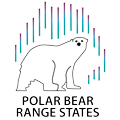Communicate to the public, policy makers, and legislators around the world the importance of mitigating Greenhouse gas emissions to polar bear conservation
The Circumpolar Action Plan (CAP) identifies climate change and the associated reductions in the extent and composition of sea ice to be the greatest threat to polar bear persistence. Climate change represents a global challenge which needs to be resolved in the international arena. Therefore, work to communicate to the public, policy makers, and legislators around the world the importance of mitigating Greenhouse gas (GHG) emissions to polar bear conservation is a Polar Bear Range States responsibility, and will provide an important contribution toward achieving the vision of the Circumpolar Action Plan.
This requires the strategic dissemination of information about the vulnerability of polar bears to the impacts of climate change, as well as the bears' current and projected status. The Polar Bear Range States should also convey the impact of climate change on the Arctic environment, including on coastal Arctic people.
The work under Objective 2 in the 2020 – 2023 Implementation Plan will be broken down into three actions:
CCC-A2: Develop a climate change communications plan that outlines key messages (e.g., how climate change effects vary among subpopulations on both temporal and spatial scales, impacts to prey and denning habitat) regarding the threat to the Arctic and to polar bears from climate change and the need for the global community to reduce GHG emissions
CCC-A3: Identify strategic communications opportunities for the Range States to provide information regarding the threat to the Arctic and to polar bears from climate change and the need for the global community to reduce GHG emissions
CCC-A5: Enter into climate change communication partnerships with organizations that have targeted audiences and strong public reach
Creating a Polar Bear Range States climate change communications plan (CCC-A2) is a key action to achieve Circumpolar Action Plan Objective 2 and will help lay the groundwork for successfully completing the other actions. The communications plan will be created by an ad hoc working group composed of Polar Bear Range States representatives as well as invited external experts, including representatives from the scientific advisory body to the Polar Bear Range States (the Polar Bear Specialist Group - PBSG), NGOs, indigenous rights holders and others, in order to ensure proper context and broad outreach. It will also serve as a starting point for developing partnerships (CCC-A5) and identifying future communication opportunities (CCC-A3).
